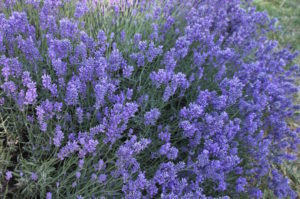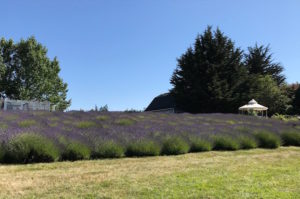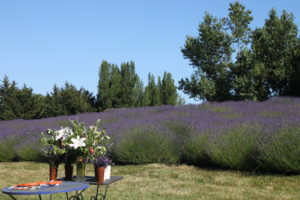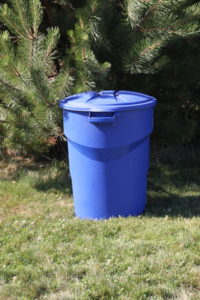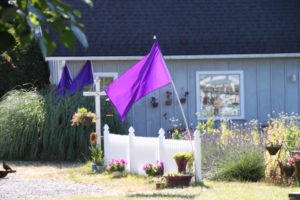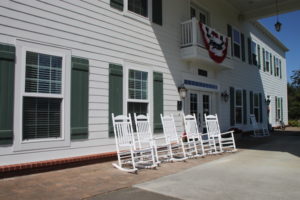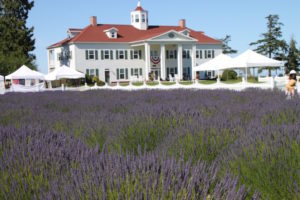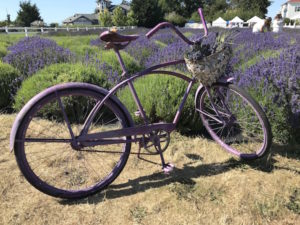It was dumb luck that, this year, my sister and I alighted in Washington state right at peak season for the lavender crop.
Lavender? When we started planning our trip, we had no idea lavender was a “thing” in Washington state. But it is, specifically in the Sequim-Dungeness Valley on the northeast corner of the Olympic Peninsula.
The valley, which boasts close to 40 lavender farms, is called America’s Provence. With the Olympic Mountains blocking rain, the area has a sunny dry climate well suited to lavender — a la the south of France.
Historically, farmers have relied on irrigation here, and some still do, but the idea for lavender farms emerged in the mid-1990s as a way to boost local agriculture with a product that didn’t need extra water. Now the farms and their scented specialty are tourist attractions.
And that was enough for us!
Map and GPS in hand, my sister (Marilyn) and I headed first for Jardin du Soleil Lavender Farm (the French name seemed fitting), which raises lavender on 10-plus acres four miles north of Sequim, the valley’s largest town.
All sorts of things on the farm were painted or dyed some shade of lavender or purple, including chairs, flags, even a garbage can, and there was an abundance of lavender, meaning the blossoms, to photograph — and sniff.
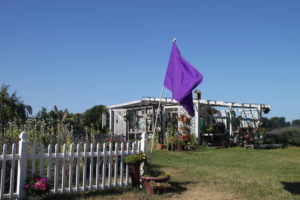
Flag and trash bin, in appropriate colors, provide accents to the scene at Jardin du Soleil Lavender Farm.
We had plenty of space for walking among the plants. I also found an open space with a small stage.
This farm promotes a Friday night music series, a Brunch in the Blooms and its Lavender Farming Experience, hands-on sessions as a lavender farmer. It was also among the 19 farms that were open to guests during the annual Sequim Lavender Weekend, the third weekend in July, 2018.
Marilyn and I were a week too early for the festival, but we missed nothing when it came to shopping. For starters, we were pleasantly surrounded by the lavender scent on entering the Jardin du Soleil shop. Then, we were surrounded by so many choices, we just had to buy more than we intended to buy.
Like many of the farms, Jardin du Soleil offered lotions and potions for bath and body; goodies — candles, sachets, sprays — meant to make sheets, towels or entire rooms smell like, well, lavender; culinary items like honey, tea and spices, and lavender-themed household goods.
Like most (or maybe all) of farms open to the public, Jardin du Soleil invites visitors to pick lavender to carry home.
I bought lots of lavender soaps, plus room sprays and lavender salts (for cooking) as gifts. So, my sister gifted me with a couple of items, including pepper laced with lavender. It’s awfully nice sprinkled on goat cheese. I aim to try that on vanilla ice cream, too.
Pleased with this farm visit, my sis and I plotted Act II for the next day, after a planned outing watching whales.
The Washington Lavender Farm was at the opposite end of this trail of lavender, with a Port Angeles address. It included, besides the fields, views of mountains to one side and water (the Strait of Juan de Fuca) to the other with, in the middle, the George Washington Inn, built to replicate Mount Vernon.
This farm hosts afternoon lavender teas and an annual colonial festival with Revolutionary War reenactments. And it sponsors the 10-day Washington Lavender Festival, which, in its final days, overlaps with the Sequim Lavender Weekend.
Unaware the farm hosted its own festival, we lucked out (again) by arriving during the event’s first weekend. We drove up a lane lined with wildflowers and were directed to parking in a large field where the inn, fronted by lavender fields, was in full view.
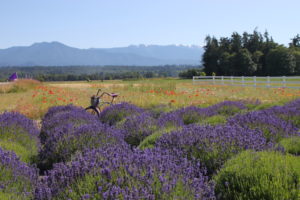
View of lavender and wildflower fields with the Olympic Mountains in the background. The George Washington Inn was at my back.
It was a hot day but, motivated, we put on the sun screen and set out. We had just missed one of the property’s afternoon teas, held on a terrace with water views. We headed thataway just the same for a look at the tea setup, which had awfully pretty lavender-themed teacups, and chatted with two hosts garbed as Martha and George Washington.
While indulging our inner photographer (note the stupendously picturesque lavender bicycle, artfully positioned for people like us), we scouted out the festival’s small crafts fair and took a quick look at equipment for distilling lavender oil.
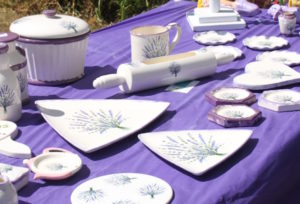
Items for sale, with the de rigueur touches of lavender, at the crafts fair during the Washington Lavender Festival on the grounds of the Washington Lavender Farm.
We didn’t miss the shop either. Among my purchases, a hand lotion that looks like soap. You hold it in your hands and let body heat transfer lotion to your skin.
And, for the perfect wrap-up, we found a shady spot to sample ice cream flavored with lavender.
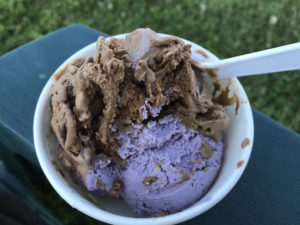
Ice cream flavored with lavender. These were lavender mint Bavarian chocolate and lavender blueberry.
The best time to visit the lavender farms can vary based on the weather. Also, there are more than 100 lavender varieties (some of which are white, BTW) in this valley, and prime times vary among them.
But, bottom line, visitors could see blooms from late June through August, with July the best bet.
At least a dozen of the nearly 40 Sequim-Dungeness Valley farms are open to visitors on a consistent basis throughout the growing season, and sometimes beyond. On the other hand, while Sequim (pronounced “squim”) is the biggest center for Washington lavender, there are other farms tourists can visit in the state, as well as choices in Oregon.
Or, I should say, there are lots of chances to get lucky.
Meanwhile, for more about the Olympic Peninsula, we offer at BestTripChoices.com the following:
https://besttripchoices.com/us-touring-areas/olympic-peninsula-washington/
This blog and photos are by Nadine Godwin, BestTripChoices.com editorial director and contributor to the trade newspaper, Travel Weekly. She also is the author of “Travia: The Ultimate Book of Travel Trivia.”

